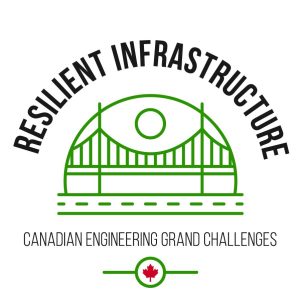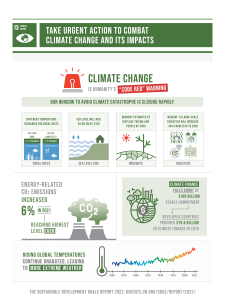CEGC 1: Resilient Infrastructure

Connection to the United Nations Sustainable Development Goals
| Infrastructure promotes the good health and well-being of society | Quality infrastructure helps to reduce inequalities by providing services regardless of income level | ||
| Infrastructure provides clean water and sanitation to the public | Infrastructure supports sustainable communities by providing for efficient networks for transportation, water and sanitation | ||
| Infrastructure supports industry and innovation by providing access to transportation and clean water | Effective infrastructure allows for efficient transportation, reducing greenhouse gas emissions |
What is the Canadian Engineering Grand Challenge Statement?
The challenge for resilient infrastructure is to ensure that infrastructure provides for the needs of communities and the economy with minimal disruptions and a high level of service in the face of changing and uncertain hazards.
High Level Overview of the Canadian Engineering Grand Challenge
Quality public infrastructure is key to safety, happiness, and economic prosperity throughout the world. Infrastructure provides invaluable services that allow for easy transportation, quick access to clean water and waste disposal. Infrastructure also offers public spaces for sport and recreation and helps to protect communities against different types of natural disasters. Canada’s infrastructure, however, is at risk. In 2019, the Canadian Core Public Infrastructure Survey (CCPIS) revealed that over a third of Canadian municipal infrastructure is in fair, poor, or very poor condition. This infrastructure will continue to degrade with time, especially when faced with atypical extreme weather events and shifting temperatures. The changing climate has increased the frequency of harmful environmental conditions such as flooding, wildfires, hurricanes, and more. Resilient infrastructure consists of infrastructure that can withstand the effects of hazards, recover quickly from interruptions in normal operation, and adapt to various long-term conditions. In order to create and maintain infrastructure that is resilient and effective, Canadian engineers must be knowledgeable, adaptable, and motivated to face the changing world ahead.
Example Connection to a Sustainable Development Goal
CEGC 1: Resilient Infrastructure maps to several Sustainable Development Goals, where an example of one of the connections is to SDG 13 – Climate Action, which has a goal to “Take urgent action to combat climate change and its impacts” (United Nations, 2023).
Figure: Infographic on Sustainable Development Goal 13 (United Nations, 2023)
Keywords: infrastructure; climate change; resilience, climate risks, aging stocks, hazards
Status of the Challenge Globally
Infrastructure across the world faces many diverse challenges. Whether seismic activity, hurricanes, or degradation over time that wears down the built environment, infrastructure is in constant need of improvement and repair.
Status of the Challenge in Canada
Age and Time
Infrastructure in Canada and throughout the world is constantly being worn down by general use as well as various weather conditions that it is exposed to. Maintaining and replacing this infrastructure as it exceeds its useful life is crucial to perpetuating the benefits that the infrastructure offers. According to the CCPIS, 39% of roads are in poor condition. There are enough Canadian roads in poor condition to build a road almost halfway to the moon (Canadian Infrastructure Report Card, n.d.). This is just one piece of the picture, with other areas of infrastructure at similar states of deterioration.
Extreme Weather Conditions
The need for climate-resilient infrastructure is greater than ever. As might be expected, extreme weather events take a serious toll on infrastructure and can lead to damage or failure. This damage is particularly serious if the infrastructure is not designed to handle the conditions it faces. In recent years climate change has led to an increase in extreme weather events such as high winds or heavy precipitation leading to flooding. The Canadian Council of Academies has recognized that climate change-exacerbated weather conditions also have the potential to cause cascading infrastructure failures (Council of Canadian Academies, 2019). Coastal areas are increasingly vulnerable as they face sea-level rise and storm surges on top of the other hazards previously noted.
Roadblocks to Success
There are several factors that make achieving resilient infrastructure a difficult task. First and foremost, infrastructure projects are expensive, time consuming, and require public support in order to proceed. Garnering public support for infrastructure maintenance can be difficult as infrastructure goes unnoticed so long as it is working properly. Public education of the important role that infrastructure plays in a healthy and functioning city is key to a community’s ability to stay resilient. The mounting climate-related struggles make it difficult to maintain, let alone invest in the future of infrastructure. Additionally, the risks to infrastructure are never guaranteed, and climate risks will continue to fluctuate based upon worldwide management of environmental changes.
Strategies to Meet 2030 Targets
To address the challenge of creating resilient infrastructure, Engineering Deans Canada (EDC) have identified the following strategies (EDC-DDIC, 2022):
- Managing and prioritizing risks from all hazards, with an emphasis on regional risks and specific hazards where appropriate like flooding and sea-level rise.
- Upgrading aging stocks of infrastructure.
- Investing in long-term and strategic infrastructure plans with a range of stable funding and finance options that accounts for the whole-life value of infrastructure in both large and small communities.
- Taking a serious approach to data collection, management and data analytics so that investments can be made where needed.
- Developing transit infrastructure – cities are getting bigger, and low income populations have limited opportunities for travel.
- Creating alternative forms of financing need to be investigated including looking into models of private-public partnerships. Small communities are lacking financing ability, in particular.
- Transforming infrastructure (especially energy, water, and wastewater) for a changing climate and to meet desirable service levels more generally.
- Exploring real time data collection and developing technologies to create “smart” infrastructure systems.
- Providing incentives to develop and implement innovative alternative types of infrastructure to achieve more cost-effective levels of service.
- Advocating for more transportation demand management strategies to achieve more efficient and effective use of our roads and highway infrastructure.
References
- Canada’s Top Climate Change Risks: The Expert Panel on Climate Change Risks and Adaptation Potential. Council of Canadian Academies. (2019, July 4). Retrieved November 24, 2022, from https://cca-reports.ca/wp-content/uploads/2019/07/Report-Canada-top-climate-change-risks.pdf
- Canadian Infrastructure Report Card. (n.d.). Retrieved February 21, 2023, from http://canadianinfrastructure.ca/downloads/canadian-infrastructure-report-card-2019.pdf
- EDC-DDIC. (2022, May 6). Canadian Engineering Grand Challenges (2020-2030). Engineering Deans Canada. Retrieved February 23, 2023, from https://engineeringdeans.ca/en/canadian-engineering-grand-challenges-2020-2030-inspiring-action-to-improve-life-for-canadians-and-the-world/
- United Nations (2023). The 17 Goals, United Nations Department of Economic and Social Affairs, Sustainable Development. Retrieved February 27, 2023, from https://sdgs.un.org/goals

